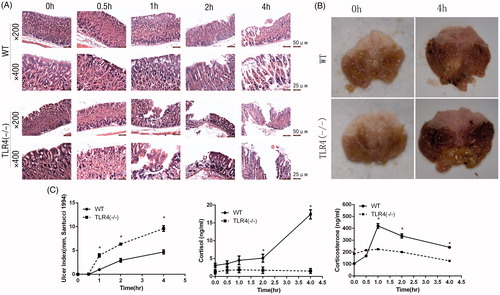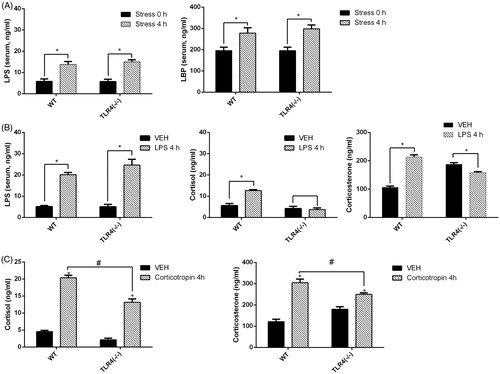Figures & data
Figure 1. Effect of TLR4 deficiency on stress-induced gastric mucosal injury. (A) Histological analysis of gastric mucosa of WT and TLR4−/− mice (n = 5 each) exposed for indicated times to water immersion restraint stress. (B) Gastric mucosa of mice (n = 5 each) stressed for 4 h. (C) Stress-induced gastric mucosal damage quantified as gastric ulcer index (UI); these values, along with serum cortisol and corticosterone concentrations, are shown as the mean ± SEM (n = 5 mice per group). *p < .05 (one-way ANOVA, Tukey’s test) versus stressed WT mice at each time point.

Figure 2. Effect of cortisol administration on stress-induced ulceration. WT and TLR4−/− mice were evaluated for (A) serum cortisol concentrations, and (B) gastric ulcer index (UI) after pretreatment with cortisol. Results represent mean ± SEM (n = 5 mice per group). *p < .05 (one-way ANOVA, Tukey’s test) versus vehicle group (dimethylsulfoxide in saline, 1:200) and control groups (without any treatment).

Figure 3. Effect of stress, lipopolysaccharide (LPS), or corticotropin on serum LPS, lipopolysaccharide-binding protein (LBP), and glucocorticoid concentrations. (A) Serum LPS and LBP concentrations after a 4-h exposure to water immersion restraint stress or not. (B) Serum LPS, cortisol, and corticosterone concentrations in mice treated with LPS or vehicle control (isotonic saline) for 4 h. (C) Serum cortisol and corticosterone concentrations in WT and TLR4−/− mice after a corticotropin (5 IU/ml, 50 IU/kg) test. Results represent mean ± SEM (n = 5). *p < .05 (one-way ANOVA, Tukey’s test) versus vehicle group. #p < .05 (one-way ANOVA, Tukey’s test) between linked groups.

Figure 4. Ultrastructure, lipid storage, and steroidogenic enzyme content in WT and TLR4−/− mouse adrenal glands. (A) Electron micrographs of adrenocortical cells in the zona fasciculata. Mitochondria (MIT), smooth endoplasmic reticulum, and liposomes (LIP) are visible in the cytoplasm of WT and TLR4−/− mice. Note the round shape, disorganized arrangement of tubulovesicular cristae, and presence of metrical vacuoles in the mutant. Scale bar 1 μm. (B) Cryosections of whole adrenal gland stained with Oil red O in WT and TLR4−/− mice without any treatment showing fewer red-stained lipid-droplets in TLR4 mutant mice. Scale bar 200 μm. (C) Western blotting of adrenal gland protein samples and the corresponding integrated optical density (IOD) ratio values (CYP11A1/glyceraldehyde 3-phosphate dehydrogenase [GAPDH]). The expression of CYP11A1 (P450scc) increased 4 h after stress or lipopolysaccharide (LPS) treatment in WT but decreased in TLR4−/− mice. Results represent mean ± SEM (n = 5 mice per group). *p < .05 versus WT vehicle group (isotonic saline). #p < .05 (one-way ANOVA, Tukey’s test) versus TLR4−/− vehicle group (isotonic saline).
![Figure 4. Ultrastructure, lipid storage, and steroidogenic enzyme content in WT and TLR4−/− mouse adrenal glands. (A) Electron micrographs of adrenocortical cells in the zona fasciculata. Mitochondria (MIT), smooth endoplasmic reticulum, and liposomes (LIP) are visible in the cytoplasm of WT and TLR4−/− mice. Note the round shape, disorganized arrangement of tubulovesicular cristae, and presence of metrical vacuoles in the mutant. Scale bar 1 μm. (B) Cryosections of whole adrenal gland stained with Oil red O in WT and TLR4−/− mice without any treatment showing fewer red-stained lipid-droplets in TLR4 mutant mice. Scale bar 200 μm. (C) Western blotting of adrenal gland protein samples and the corresponding integrated optical density (IOD) ratio values (CYP11A1/glyceraldehyde 3-phosphate dehydrogenase [GAPDH]). The expression of CYP11A1 (P450scc) increased 4 h after stress or lipopolysaccharide (LPS) treatment in WT but decreased in TLR4−/− mice. Results represent mean ± SEM (n = 5 mice per group). *p < .05 versus WT vehicle group (isotonic saline). #p < .05 (one-way ANOVA, Tukey’s test) versus TLR4−/− vehicle group (isotonic saline).](/cms/asset/03c44cd0-9f59-47c6-9eff-a4a573905e21/ists_a_1224843_f0004_c.jpg)
